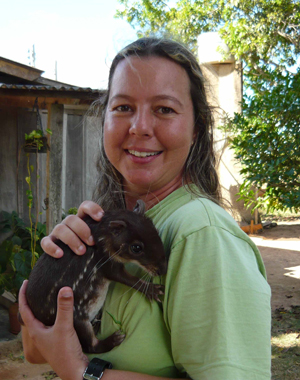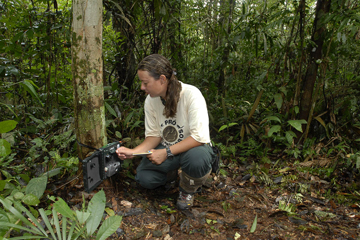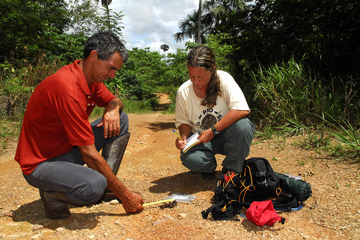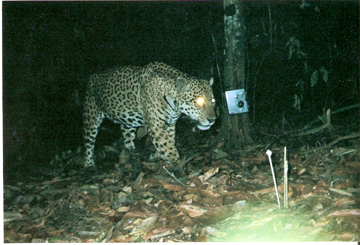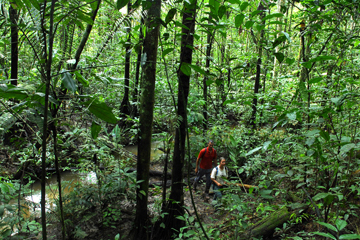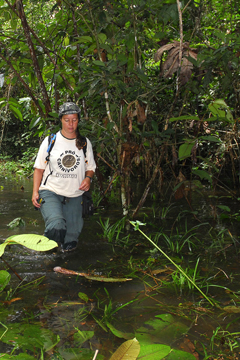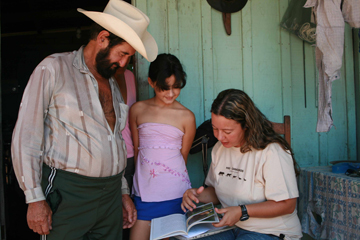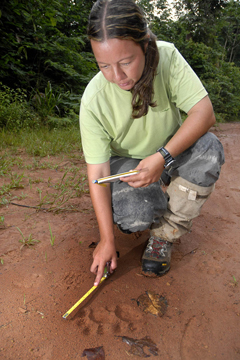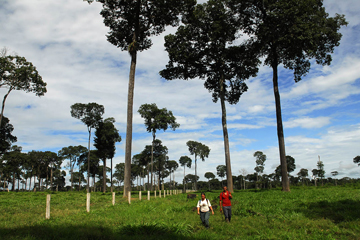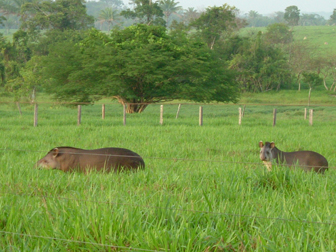Forest corridors key to maintaining biodiversity in fragmented landscape:
An interview with Brazilian carnivore researcher Fernanda Michalski
Rhett A. Butler, mongabay.com
October 7, 2008
|
|
Alta Floresta, a region in the Brazilian Amazon state of Mato Grosso, has experienced one of the highest deforestation rates on the planet since the mid-1980s due to the influx of colonists and ranchers who converted nearly half the region's forest land to pasture and agricultural plots. The change has had significant ecological impacts, including reducing the availability of water, increasing the incidence of forest fires, fragmenting remaining forest cover, and diminishing the quality of habitat for wildlife.
|
|
Dr. Fernanda Michalski, a biologist with the University of São Paulo and Pró-Carnívoros, a Brazilian wildlife NGO, is studying the impact of this transformation on mammals in Alta Florest in order to determine how to best maintain the region's remaining biodiversity. Consistent with other regions, Michalski has found that fragment size is a key determinant of biodiversity: larger fragments support more wildlife species. But smaller fragments can still play an important role in wildlife conservation, especially when connected to other fragments via riverine forest corridors. Michalski has amassed evidence to show that corridors are critical for allowing movement of animals between forest fragments in an otherwise "hostile" landscape for wildlife.
However other factors also affect the survival of wildlife, particularly carnivores which are often perceived — usually unjustly — as a major cause of livestock mortality. Michalski is working with ranchers to show that not only are puma, jaguars, and other predators blamed for an unfair share of livestock loss, but that reducing livestock predation is neither costly, nor difficult.
|
|
Michalski is also examining the broader trends for remaining forests in Alta Floresta. Her outlook is not good. In a recent paper Michalski and colleagues forecast a further 50 percent loss of forest cover within the next 8 years, suggests that Alta Floresta's forest cover will fall to 21 percent by 2016, down from 91 percent in 1984. She says the impacts of forest loss extend well beyond the region, the Brazilian Amazon, and even Brazil.
"Millions of people depend on farm land that was once Amazon forest for their food and livelihoods, but billions depend on the Amazon for the maintenance of global carbon and hydrologic systems," she told mongabay.com. "I believe Brazil has the technology and expertise to increase production and profitability within existing agricultural areas to meet future demands but there is a need for international cooperation to assist and incentivize the delivery of new agricultural and management systems so that it less financially attractive to continue clearing new areas."
Michalski discussed this and more in an October 2008 interview with mongabay.com.
An interview with Fernanda Michalski of ProCarnivoros
Mongabay: What is your background and how did you get interested in study carnivores in the Amazon?
Fernanda Michalski: I have always had a passion for wildlife. When I was eight years old I used to spend hours watching Jacques Cousteau’s Amazon journeys. My interest in carnivores started when I did my Masters degree with Peter Crawshaw, studying small carnivores in a fragmented region of the Atlantic forest in 1997-2000. From that time I started reading books by George Schaller and my interest in conservation biology and carnivores has continued to increase each day since then.
|
|
After that, in 2001, I had a chance to start working with fragmentation and conservation in the Brazilian Amazon with Carlos Peres and my experience walking with him in the forest made me see another world in front of me. Then I got the idea to combine my passion for carnivores and the study of the Brazilian Amazon and I just cannot imagine myself doing anything else.
Mongabay: Do you focus on particular species or all mammals in your study area?
Fernanda Michalski: I have learned that we need to study a variety of functional groups to understand how they are responding to problems such as fragmentation and anthropogenic disturbances. Currently, I work with mid-sized and large-bodied mammal species ranging from squirrels to tapirs. Within these groups I can then focus on certain species to answer specific questions.
Mongabay: How do you track wildlife?
|
|
Fernanda Michalski: My current studies use only non-invasive techniques, ranging from interviews with landowners, systematic searches for signs of presence of a species (e.g. tracks) to techniques such as line-transect census, camera trapping and more recently DNA based-identification of scats.
Mongabay: What have you learned about animal movement in frontier areas and between forest fragments? What about the significance of riverine corridors?
Fernanda Michalski: When I was studying forest fragments for my PhD I would find signs of the presence of Jaguars and White-lipped peccaries in 1000-ha fragments. I started to question how these wide ranging species perceived the landscape and how they used the hostile matrix (pasture) in order to move between forested areas. I also started to notice a higher abundance of tracks of mammals around riverine corridors, which have been protected by Brazilian Federal legislation since 1965. However, I just had the chance to study in detail the use of riparian corridors by mammals in my post-doc with Jean Paul Metzger which started in 2007.
|
|
After monitoring more than 15 riparian corridors for more than one year in the Alta Floresta region (in the Brazilian state of Mato Grosso) I can say that it is very important to maintain connectivity and allow individual movement between forest fragments in fragmented landscapes. I found that riparian corridors are especially important for White-lipped peccaries, medium and large felids, and spider monkeys.
In particular, I found riparian corridors that have more than 200 meters in width are used by spider monkeys when connecting forest fragments.
Mongabay: Is the area the most significant factor in what species disappear from a fragment?
Fernanda Michalski: Definitely, I found that forest fragment area explains 90% of the variation in mammal species richness in the Alta Floresta region. Large mammal species were typically absent from fragments with less than 100 ha and my findings highlight the importance of large forest areas (greater than 10 000 ha) to maximize species persistence and maintain baseline abundances of Neoropical forest mammal species.
Mongabay: What are other factors that contribute to local species extinction from forest patches?
|
|
Fernanda Michalski: After forest area, anthropogenic disturbances (such as logging, hunting and fire) can contribute to local species extinction from forest fragments. I found evidence that burn severity, logging intensity and hunting pressure affect species persistence and relative abundance of mammal species in our study area. Large predators such as Pumas and Jaguars are also heavily persecuted in deforestation frontiers due to predation on domestic livestock.
Mongabay: What are the main drivers of deforestation and degradation in the Alta Floresta region?
Fernanda Michalski: I found that deforestation was mainly driven by cattle ranching in the Alta Floresta region. From 1984 to 2004 the forest cover in the region declined from 91% to 42% and our prediction is that if current levels of deforestation persist, in 2016 only 21% of forest cover will be left. Additionally to cattle ranching, Alta Floresta produced over 90 tonnes of gold from 1980 to 1996 and attracted an influx of migrants from other parts of Brazil, which in turn also contributed to a significant increase in regional deforestation levels.
Mongabay: Is hunting a significant threat to other types of wildlife?
Fernanda Michalski: Many researchers have found that hunting is a serious threat to many wildlife populations. I found a negative effect of hunting pressure on White-lipped peccary abundance. However, most large mammal species in Alta Floresta are not heavily persecuted by hunters, perhaps due to the high supply of animal protein from domestic livestock (~17 cattle/person), so hunting was only significant for this mammal species.
Mongabay: How do you convince people not to kill jaguar, puma and other predators? Are there compensation programs for lost livestock? How big an impact do carnivores have on livestock? Is this something that is overestimated by ranchers?
|
|
Fernanda Michalski: This is something that is very difficult to deal with here as is in other parts of Brazil. We constantly need to try to convince people to not kill jaguars, pumas and other predators. My experience working here for almost 7 years taught me that the best approach is to get in close contact with the landowners and gradually convince them of the importance of these animals. I always speak with them about cost effective and practical ways to avoid and minimize predation problems based on simple cattle management such as leaving young animals farther from the forest border and keeping an eye on tracks of large predators to avoid placing calves in these areas. Another approach is to try to increase their interest in these animals. I found that in all the farms where I worked with camera trapping, the landowners always want to see the jaguar pictures instead of those of other species, showing that they do like to see the animal.
|
|
We do not have compensation programs for lost livestock here. I found that the biggest loss from predators occurs on large properties (with more than 1500 head of cattle) with an average of only US$885 lost annually in Alta Floresta region due to cattle predation. These results agree with other studies across Neotropical areas that show that the revenue lost is insignificant compared with the income of the large farms. Farmers usually overestimate the impact of carnivores on livestock. Several times they forget to count how many livestock they lose with health problems (e.g. diseases) and poisoning from plants due to lack of pasture management.
However compensation schemes could be something to be implemented here in the near future in order to minimize impact of predator’s kills especially in small-sized farms where the loss of even one animal can significantly impact the household revenue.
Mongabay: What is the best way to protect habitat in Alta Floresta? What about wildlife?
Fernanda Michalski: The current proportion of forest cover can be maintained by ensuring the continuation of readily available data from satellite monitoring in combination with in situ law enforcement of Brazilian forest legislation, especially during the dry season when most of the deforestation takes place. Additionally, the creation of protected areas in public land and environmental education of landowners in private areas can help maintain and conserve forests and biodiversity.
Mongabay: What is your outlook for the region in terms of forest cover? What about the greater Amazon?
|
|
Fernanda Michalski: If observed deforestation probabilities remain unchanged, I predicted that only 21% of the forest cover will remain in the study region by 2016, well bellow estimates of sustainable forest cover in the Amazon based on metrics of landscape structure, ecosystem services under future climate change scenarios and current levels of bird and mammal species persistence.
Annual deforestation has accelerated in the Brazilian Amazon in recent years and its future is not looking any better than in our study region.
Mongabay: What do you think is the best way to moderate deforestation in the Brazilian Amazon?
Fernanda Michalski: To moderate deforestation in the Brazilian Amazon we need to enable sustainable development. Millions of people depend on farm land that was once Amazon forest for their food and livelihoods, but billions depend on the Amazon for the maintenance of global carbon and hydrologic systems. I believe Brazil has the technology and expertise to increase production and profitability within existing agricultural areas to meet future demands but there is a need for international cooperation to assist and incentivize the delivery of new agricultural and management systems so that it less financially attractive to continue clearing new areas.
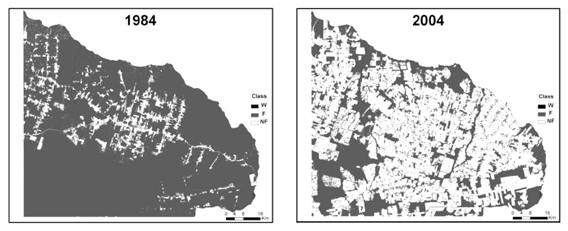 A series of land-use maps representing the evolution of the landscape structure in the Alta Floresta region at four-year intervals throughout through study period. Land-cover classes are represented by water (W), forest (F) and non-forest (NF). Courtesy of Michalski et al (2008)
A series of land-use maps representing the evolution of the landscape structure in the Alta Floresta region at four-year intervals throughout through study period. Land-cover classes are represented by water (W), forest (F) and non-forest (NF). Courtesy of Michalski et al (2008)Mongabay: What are the best ways for Brazilians to help conserve wildlife?
Fernanda Michalski: As a research scientist I believe the best way to help conserve wildlife is to have more research and students/professionals working in areas with a lack of research in Brazil. It is incredible the number of people working in some areas close to the main cities in Brazil such as Rio de Janeiro and São Paulo. However, only few groups are currently working in more remote areas such as the Amazon.
Mongabay: What are the best ways for Brazilians to help conserve the Amazon? Is there much consumer interest in "green" or "environmentally-friendly" products like certified timber and beef?
|
|
Fernanda Michalski: The interest in ‘green’ products would be a very effective way to help in conserving the Amazon in my opinion. However, the demand for such "green" products in Brazil is weak. People still lack this feeling of conservation and because certified timber and beef products are usually more expensive and harder to find and acquire compared with the non certified ones they usually don’t attract consumers as much as they could. The media and educational campaigns could improve people’s perception towards these products.
Michalski’s current project is supported by FAPESP; the Wildlife Conservation Society; the Conservation, Food & Health Foundation; Cleveland Metroparks Zoo and The Cleveland Zoological Society; and The Rufford Small Grants Foundation.
Michalski works for Instituto Pro-Carnivoros
